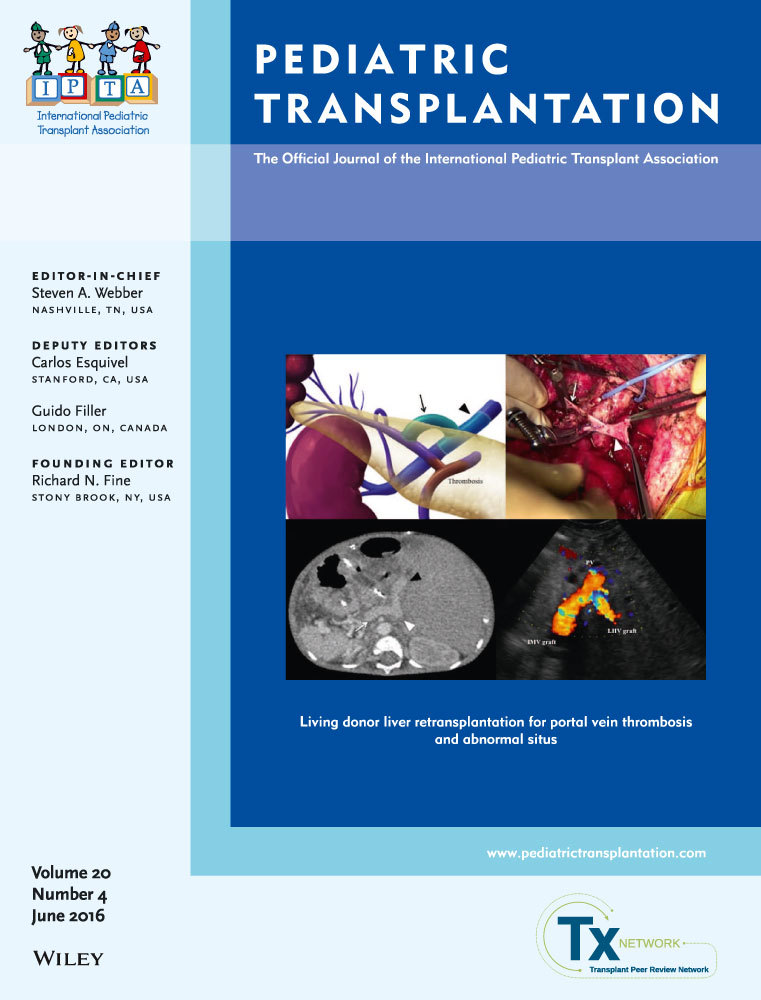Resolution of Graves’ disease after renal transplantation
Lavjay Butani
Section of Nephrology, Department of Pediatrics, University of California, Davis, Sacramento, CA, USA
Search for more papers by this authorNicole Glaser
Section of Endocrinology, Department of Pediatrics, University of California, Davis, Sacramento, CA, USA
Search for more papers by this authorCorresponding Author
Stephanie Nguyen
Section of Nephrology, Department of Pediatrics, University of California, Davis, Sacramento, CA, USA
Stephanie Nguyen, Department of Pediatrics, UC Davis Children's Hospital, 2516 Stockton Blvd., Sacramento, CA 95817, USA
Tel.: 916 734 8118
Fax: 916 734 0629
E-mail: [email protected]
Search for more papers by this authorLavjay Butani
Section of Nephrology, Department of Pediatrics, University of California, Davis, Sacramento, CA, USA
Search for more papers by this authorNicole Glaser
Section of Endocrinology, Department of Pediatrics, University of California, Davis, Sacramento, CA, USA
Search for more papers by this authorCorresponding Author
Stephanie Nguyen
Section of Nephrology, Department of Pediatrics, University of California, Davis, Sacramento, CA, USA
Stephanie Nguyen, Department of Pediatrics, UC Davis Children's Hospital, 2516 Stockton Blvd., Sacramento, CA 95817, USA
Tel.: 916 734 8118
Fax: 916 734 0629
E-mail: [email protected]
Search for more papers by this authorAbstract
We report a case of an adolescent boy with Down's syndrome and ESRD on hemodialysis who developed mild Graves’ disease that was not amenable to radioablation, surgery, or ATDs. After 14 months of observation without resolution of Graves’ disease, he successfully received a DDRT with a steroid minimization protocol. Thymoglobulin and a three-day course of steroids were used for induction and he was started on tacrolimus, MMF, and pravastatin for maintenance transplant immunosuppression. One month after transplantation, all biochemical markers and antibody profiling for Graves’ disease had resolved and remain normal one yr later.
References
- 1Varughese GI, Tahrani AA, Smith JL, Clayton RN, Hanna FW. Carbimazole therapy in the setting of end-stage renal disease and haemodialysis. Nephrol Dial Transplant 2006: 21: 2318–2319.
- 2Nair CG, Jacob P, Menon R, Babu MJ. Graves’ disease in a dialysis dependent chronic renal failure patient. Indian J Nephrol 2014: 24: 397–399.
- 3Holst JP, Burman KD, Atkins F, Umans JG, Jonklaas J. Radioiodine therapy for thyroid cancer and hyperthyroidism in patients with end-stage renal disease on hemodialysis. Thyroid 2005: 15: 1321–1331.
- 4Hofle G, Moncayo R, Baldissera I, Pfister R, Finkenstedt G. Endocrine ophthalmopathy in a patient under continuous immunosuppressive therapy after cardiac transplantation. Thyroid 1995: 5: 477–480.
- 5Peces R, Navascues RA, Baltar J, Laures AS, Ortega F, Alvarez-Grande J. Hyperthyroidism in a renal transplant recipient. Am J Nephrol 1998: 18: 560–561.
- 6Lau KK, Berg GM, Schjoneman YG, Perez RV, Butani L. Extended experience with a steroid minimization immunosuppression protocol in pediatric renal transplant recipients. Pediatr Transplant 2010: 14: 488–495.
- 7Ikekubo K, Hino M, Ito H, et al. Thyrotoxic Graves’ disease with normal thyroidal technetium-99 m pertechnetate uptake. Ann Nucl Med 1990: 4: 43–48.
- 8Pellegrini FP, Marinoni M, Frangione V, et al. Down syndrome, autoimmunity and T regulatory cells. Clin Exp Immunol 2012: 169: 238–243.
- 9Codaccioni JL, Orgiazzi J, Blanc P, Pugeat M, Roulier R, Carayon P. Lasting remissions in patients treated for Graves’ hyperthyroidism with propranolol alone: A pattern of spontaneous evolution of the disease. J Clin Endocrinol Metab 1988: 67: 656–662.
- 10De Luca F, Corrias A, Salerno M, et al. Peculiarities of Graves’ disease in children and adolescents with Down's syndrome. Eur J Endocrinol 2010: 162: 591–595.
- 11Rivkees SA. Pediatric Graves’ disease: Controversies in management. Horm Res Paediatr 2010: 74: 305–311.
- 12Goday-Arno A, Cerda-Esteva M, Flores-Le-Roux JA, Chillaron-Jordan JJ, Corretger JM, Cano-Perez JF. Hyperthyroidism in a population with Down syndrome (DS). Clin Endocrinol 2009: 71: 110–114.
- 13Glaser NS, Styne DM, Organization of Pediatric Endocrinologists of Northern California Collaborative Graves’ Disease Study Group. Predicting the likelihood of remission in children with Graves’ disease: A prospective, multicenter study. Pediatrics 2008: 121: e481–e488.
- 14Kubota S, Ohye H, Nishihara E, et al. Effect of high dose methylprednisolone pulse therapy followed by oral prednisolone administration on the production of anti-TSH receptor antibodies and clinical outcome in Graves’ disease. Endocr J 2005: 52: 735–741.
- 15Dalan R, Leow MKS. Immune manipulation for Graves’ disease: Re-exploring an unfulfilled promise with modern translational research. Eur J Intern Med 2012: 23: 682–691.
- 16Heemstra KA, Toes RE, Sepers J, et al. Rituximab in relapsing Graves’ disease, a phase II study. Eur J Endocrinol 2008: 159: 609–615.
- 17Kurozumi A, Okada Y, Arao T, et al. Induction of thyroid remission using rituximab in a patient with type 3 autoimmune polyglandular syndrome including Graves’ disease and type 1 diabetes mellitus: A case report. Endocr J 2015: 62: 69–75.
- 18Salvi M, Vannucchi G, Curro N, et al. Efficacy of B-cell targeted therapy with rituximab in patients with active moderate to severe Graves’ orbitopathy: A randomized controlled study. J Clin Endocrinol Metab 2015: 100: 422–431.
- 19Stan MN, Garrity JA, Carranza Leon BG, Prabin T, Bradley EA, Bahn RS. Randomized controlled trial of rituximab in patients with Graves’ orbitopathy. J Clin Endocrinol Metab 2015: 100: 432–441.
- 20Gaber AO, Monaco A, Russell J, Lebranchu Y, Mohty M. Rabbit antithymocyte globulin (Thymoglobulin®). Drugs 2010: 70: 691–732.
- 21Zand MS, Vo T, Huggins J, et al. Polyclonal rabbit antithymocyte globulin triggers B-cell and plasma cell apoptosis by multiple pathways. Transplantation 2005: 79: 1507–1515.
- 22Gurkan S, Luan Y, Dhillon N, et al. Immune reconstitution following rabbit antithymocyte globulin. Am J Transplant 2010: 10: 2132–2141.
- 23Gitelman SE, Gottlieb PA, Rigby MR, et al. Antithymocyte globulin treatment for patients with recent-onset type 1 diabetes: 12-month results of a randomised, placebo-controlled, phase 2 trial. Lancet Diabetes Endocrinol 2013: 1: 306–316.
- 24Shin JI, Park JM, Lee JS, Kim DH, Jeong HJ. Development of Graves’ disease during cyclosporin treatment for severe Henoch-Schonlein nephritis. Nephrol Dial Transplant 2005: 20: 2014–2015.
- 25Gillard P, Huurman V, Van Der Auwera B, et al. Graves hyperthyroidism after stopping immunosuppressive therapy in type 1 diabetic Islet cell recipients with pretransplant TPO autoantibodies. Diabetes Care 2009: 32: 1817–1819.




